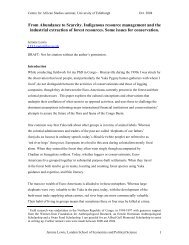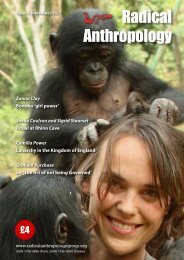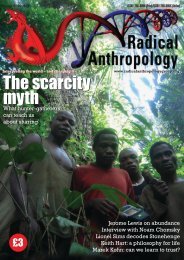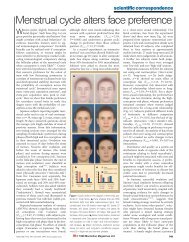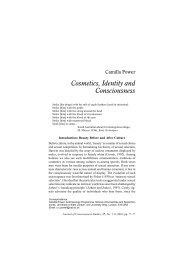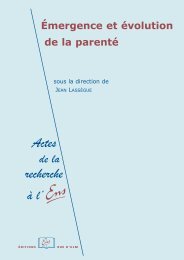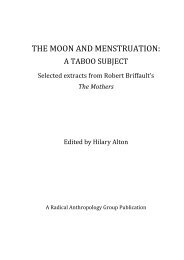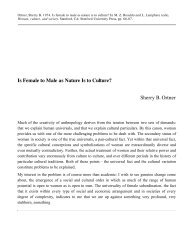Language and life history: A new perspective on the development ...
Language and life history: A new perspective on the development ...
Language and life history: A new perspective on the development ...
- No tags were found...
You also want an ePaper? Increase the reach of your titles
YUMPU automatically turns print PDFs into web optimized ePapers that Google loves.
References/Locke & Bogin: <str<strong>on</strong>g>Language</str<strong>on</strong>g> <str<strong>on</strong>g>and</str<strong>on</strong>g> <str<strong>on</strong>g>life</str<strong>on</strong>g> <str<strong>on</strong>g>history</str<strong>on</strong>g>Potts, R. (1988) Early hominid activities at Olduvai. Aldine de Gruyter. [aJLL]Power, C. & Aiello, L. C. (1997) Female proto-symbolic strategies. In: Women inhuman evoluti<strong>on</strong>, ed. L. D. Hager, pp. 153–71. Routledge. [CK]Powers, D. M. W. (1992) On <strong>the</strong> significance of closed classes <str<strong>on</strong>g>and</str<strong>on</strong>g> boundary c<strong>on</strong>diti<strong>on</strong>s:Experiments in lexical <str<strong>on</strong>g>and</str<strong>on</strong>g> syntactic learning. In: Background <str<strong>on</strong>g>and</str<strong>on</strong>g>experiments in machine learning of natural language: First SHOE workshop,ITK Proceedings 92/1, Tilburg University, The Ne<strong>the</strong>rl<str<strong>on</strong>g>and</str<strong>on</strong>g>s, ed. W. Daelemans& D. M. W. Powers, pp. 245–66. Available at: http://www.infoeng.flinders.edu.au/papers/19920001.pdf.[DMWP]Powers, D. M. W. & Turk, C. C. R. (1989) Machine learning of natural language.Springer-Verlag. [DMWP]Prader, A. (1984) Biomedical <str<strong>on</strong>g>and</str<strong>on</strong>g> endocrinological aspects of normal growth <str<strong>on</strong>g>and</str<strong>on</strong>g><strong>development</strong>. In: Human growth <str<strong>on</strong>g>and</str<strong>on</strong>g> <strong>development</strong>, ed. J. Borms, R. Hauspie,A. S<str<strong>on</strong>g>and</str<strong>on</strong>g>, C. Susanne & M. Hebbelinck. Plenum. [aJLL]Prader, A., Tanner, J. M. & V<strong>on</strong> Harnack, G. A. (1963) Catch-up growth followingillness or starvati<strong>on</strong>. Journal of Paediatrics 62:646–59. [rJLL]Premack, D. (2004) Is language <strong>the</strong> key to human intelligence? Science 303:318–20. [JVH]Prince, C. G., Helder, N. & Hollich, G. (2005) Ongoing emergence: A core c<strong>on</strong>ceptin epigenetic robotics. In: Proceedings of <strong>the</strong> Fifth Internati<strong>on</strong>al Workshop <strong>on</strong>Epigenetic Robotics: Modeling cognitive <strong>development</strong> in robotic systems, Nara,Japan. ed. L. Berthouze, F. Kaplan, H. Kozima, H. Yano, J. K<strong>on</strong>czak, G. Metta,J. Nadel, G. S<str<strong>on</strong>g>and</str<strong>on</strong>g>ini, G. Stojanov, & C. Balkaneius, pp. 63–70. LundUniversity Cognitive Studies. [LJG]Prince, C. G. & Hollich, G. (2005) Synching models with infants: A perceptual-levelmodel of infant audio-visual synchr<strong>on</strong>y detecti<strong>on</strong>. Journal of Cognitive SystemsResearch 6:205–28. Available at: http://www.cprince.com/PubRes/JCSR04. [LJG]Promislow, D. & Harvey, P. (1990) Living fast <str<strong>on</strong>g>and</str<strong>on</strong>g> dying young: A comparativeanalysis of <str<strong>on</strong>g>life</str<strong>on</strong>g>-<str<strong>on</strong>g>history</str<strong>on</strong>g> variati<strong>on</strong> am<strong>on</strong>g mammals. Journal of Zoology, L<strong>on</strong>d<strong>on</strong>220:417–37. [PK]Prutting, C. A. & Kirchner, D. M. (1987) A clinical appraisal of <strong>the</strong> pragmaticaspects of language. Journal of Speech <str<strong>on</strong>g>and</str<strong>on</strong>g> Hearing Disorders52:105–19. [aJLL]Pusey, A. (1983) Mo<strong>the</strong>r-offspring relati<strong>on</strong>ships in chimpanzees after weaning.Animal Behavior 31:363–77. [rJLL]Putallaz, M. & Gottman, J. M. (1981) Social skills <str<strong>on</strong>g>and</str<strong>on</strong>g> group acceptance. In: The<strong>development</strong> of children’s friendships, ed. S. R. Asher & J. M. Gottman.Cambridge University Press. [aJLL]Puts, D. A. (2005) Mating c<strong>on</strong>text <str<strong>on</strong>g>and</str<strong>on</strong>g> menstrual phase affect women’s preferencesfor male voice pitch. Evoluti<strong>on</strong> <str<strong>on</strong>g>and</str<strong>on</strong>g> Human Behavior 26:388–97. [rJLL]Puts, D. A., Gaulin, S. J. C. & Verdolini, K. (2005) Dominance <str<strong>on</strong>g>and</str<strong>on</strong>g> <strong>the</strong> evoluti<strong>on</strong> ofsexual dimorphism in human voice pitch. Evoluti<strong>on</strong> <str<strong>on</strong>g>and</str<strong>on</strong>g> Human Behavior27:283–96. [rJLL]Raffaelli, M. & Duckett, E. (1989) “We were just talking ...” – C<strong>on</strong>versati<strong>on</strong>s inearly adolescence. Journal of Youth <str<strong>on</strong>g>and</str<strong>on</strong>g> Adolescence 18:567–82. [aJLL]Ragir, S. (1985) Retarded <strong>development</strong>: The evoluti<strong>on</strong>ary mechanism underlying<strong>the</strong> emergence of <strong>the</strong> human capacity for language. Journal of Mind <str<strong>on</strong>g>and</str<strong>on</strong>g>Behavior 6(4):451–68. [SR](2001a) Changes in perinatal c<strong>on</strong>diti<strong>on</strong>s selected for ne<strong>on</strong>atal immaturity.Behavioral <str<strong>on</strong>g>and</str<strong>on</strong>g> Brain Sciences 24(2):291–92. [SR](2001b) Toward an underst<str<strong>on</strong>g>and</str<strong>on</strong>g>ing of <strong>the</strong> relati<strong>on</strong>ship between bipedal walking,encephalizati<strong>on</strong>, <str<strong>on</strong>g>and</str<strong>on</strong>g> language origins. In: <str<strong>on</strong>g>Language</str<strong>on</strong>g> evoluti<strong>on</strong>: Biological,linguistic <str<strong>on</strong>g>and</str<strong>on</strong>g> philosophical <str<strong>on</strong>g>perspective</str<strong>on</strong>g>s, ed. G. Gyori, pp. 73–99. PeterLang. [SR](2002) C<strong>on</strong>straints <strong>on</strong> communities with indigenous sign languages: Clues to<strong>the</strong> dynamics of language origins. In: The transiti<strong>on</strong> to language, ed. A. Wray,pp. 272–94. Oxford University Press. [HB]Ramirez Rozzi, F. V. & Bermudez De Castro, J. M. (2004) Surprisingly rapidgrowth in Ne<str<strong>on</strong>g>and</str<strong>on</strong>g>erthals. Nature 428:936–99. [aJLL]Ramus, F., Hauser, M. D., Miller, C., Morris, D. & Mehler, J. (2000) <str<strong>on</strong>g>Language</str<strong>on</strong>g>discriminati<strong>on</strong> by human <str<strong>on</strong>g>new</str<strong>on</strong>g>borns <str<strong>on</strong>g>and</str<strong>on</strong>g> by cott<strong>on</strong>-top tamarin m<strong>on</strong>keys.Science 288:349–51. [KW]Ray, G. B. (1986) Vocally cued pers<strong>on</strong>ality prototypes: An implicit pers<strong>on</strong>ality<strong>the</strong>ory approach. Communicati<strong>on</strong> M<strong>on</strong>ographs 53:266–76. [aJLL]Reay, M. (1959) The Kuma: Freedom <str<strong>on</strong>g>and</str<strong>on</strong>g> c<strong>on</strong>formity in <strong>the</strong> New Guinea Highl<str<strong>on</strong>g>and</str<strong>on</strong>g>s.Melbourne University Press. [aJLL]Reddy, M. J. (1993) The c<strong>on</strong>duit metaphor: A case of frame c<strong>on</strong>flict in our languageabout language. In Metaphor <str<strong>on</strong>g>and</str<strong>on</strong>g> thought, ed. A. Ort<strong>on</strong>y, pp. 164–201.Cambridge University Press. [BJK]Reed, V. A., Bradfield, M. & McAllister, L. (1998) The relative importance ofselected communicati<strong>on</strong> skills for successful adolescent peer interacti<strong>on</strong>s:Speech pathologists’ opini<strong>on</strong>s. Clinical Linguistics <str<strong>on</strong>g>and</str<strong>on</strong>g> Ph<strong>on</strong>etics12:205–20. [aJLL]Reed, V. A. & Spicer, L. (2003) The relative importance of selected communicati<strong>on</strong>skills for adolescents’ interacti<strong>on</strong>s with <strong>the</strong>ir teachers: High school teachers’opini<strong>on</strong>s. <str<strong>on</strong>g>Language</str<strong>on</strong>g> Speech, <str<strong>on</strong>g>and</str<strong>on</strong>g> Hearing Services in Schools34:343–57. [aJLL]Relethford, J. (2006) The human species: an introducti<strong>on</strong> to biological anthropology,6 th editi<strong>on</strong>. McGraw-Hill. [arJLL]Rice, M. (1993) “D<strong>on</strong>’t talk to him; he’s weird.” A social c<strong>on</strong>sequences account oflanguage <str<strong>on</strong>g>and</str<strong>on</strong>g> social interacti<strong>on</strong>s. In: Enhancing children’s communicati<strong>on</strong>:Research foundati<strong>on</strong>s for interventi<strong>on</strong>, ed. A. P. Kaiser & D. B. Gray. PaulH. Brookes. [aJLL]Richman, B. (1980) Did human speech originate in coordinated vocal music?Semiotica 32:233–44. [rJLL](1987) Rhythm <str<strong>on</strong>g>and</str<strong>on</strong>g> melody in gelada vocal exchanges. Primates28:199–223. [rJLL](2000) How music fixed “n<strong>on</strong>sense” into significant formulas: On rhythm, repetiti<strong>on</strong>,<str<strong>on</strong>g>and</str<strong>on</strong>g> meaning. In: The origins of music, ed. N. L. Wallin, B. Merker &S. Brown. MIT Press. [aJLL]Rimpau, J. B., Gardner, R. A. & Gardner, B. T. (1989). Expressi<strong>on</strong> of pers<strong>on</strong>, place,<str<strong>on</strong>g>and</str<strong>on</strong>g> instrument in ASL utterances of children <str<strong>on</strong>g>and</str<strong>on</strong>g> chimpanzees. In: Teachingsign language to chimpanzees, ed. R. A. Gardner, B. T. Gardner & T. E. VanCantfort. State University of New York Press. [RAG]Rivers, W. H. R. (1907) The marriage of cousins in India. Journal of <strong>the</strong> AsiaticSociety 611–940. [IB]Roazzi, A., Dowker, A. & Bryant, P. (1993) Ph<strong>on</strong>ological abilities of Brazilian streetpoets. Applied Psycholinguistics 14(4):535–51. [rJLL]Roazzi, A., Dowker, A. & Bryant, P. E. (1994) Metalinguistic awareness in Brazilianbards. In: Journeys into cross-cultural psychology, ed. A. Bouvy & F. J. R. V<str<strong>on</strong>g>and</str<strong>on</strong>g>e Vijver, pp. 83–85. Lisse. [rJLL]Robb, M. P., Hughes, M. C. & Frese, D. J. (1985) Oral diadochokinesis inhearing-impaired adolescents. Journal of Communicati<strong>on</strong> Disorders18:79–89. [aJLL]Rochat, P., Querido, J. G. & Striano, T. (1999) Emerging sensitivity to <strong>the</strong> timing<str<strong>on</strong>g>and</str<strong>on</strong>g> structure of protoc<strong>on</strong>versati<strong>on</strong> in early infancy. Developmental Psychology35:950–57. [SR]Rogoff, B. (1996) Developmental transiti<strong>on</strong>s in children’s participati<strong>on</strong> in socioculturalactivities. In: The five to seven year shift: The age of reas<strong>on</strong> <str<strong>on</strong>g>and</str<strong>on</strong>g>resp<strong>on</strong>sibility, ed. A. J. Sameroff & M. M. Haith. University of ChicagoPress. [aJLL]Ross, D. (in press) Homo sapiens as ecologically special: What does languagec<strong>on</strong>tribute? <str<strong>on</strong>g>Language</str<strong>on</strong>g> Sciences. [SJC]Rowley, I. & Chapman, G. (1986) Cross-fostering, imprinting <str<strong>on</strong>g>and</str<strong>on</strong>g> learning in twosympatric species of cockatoos. Behaviour 96:1–16. [RAG]Ruscello, D. M., Lass, N. J. & Podbesek, J. (1988) Listeners’ percepti<strong>on</strong>s of normal<str<strong>on</strong>g>and</str<strong>on</strong>g> voice-disordered children. Folia Ph<strong>on</strong>iatrica 40:290–96. [aJLL]Rutter, M. & O’C<strong>on</strong>nor, T. G. (2004) Are <strong>the</strong>re biological programming effects forpsychological <strong>development</strong>? Findings from a study of Romanian adoptees.Developmental Psychology 40:81–94. [aJLL]Ruzza, B., Rocca, F., Lenti Boero, D. & Lenti C. (2003) Investigating <strong>the</strong> musicalqualities of early infant sounds. In: The Neurosciences <str<strong>on</strong>g>and</str<strong>on</strong>g> music: Annals of <strong>the</strong>New York Academy of Sciences, vol. 999, ed. G. Avanzini, C. Faienza,D. Minciacchi, L. Lopez & L. Majno, pp. 527–30. The New York Academy ofSciences. [DLB]Sachs, J. (1987) Preschool boys’ <str<strong>on</strong>g>and</str<strong>on</strong>g> girls’ language use in pretend play. In:<str<strong>on</strong>g>Language</str<strong>on</strong>g>, gender, <str<strong>on</strong>g>and</str<strong>on</strong>g> sex in comparative <str<strong>on</strong>g>perspective</str<strong>on</strong>g>, ed. S. U. Philips,S. Steele & C. Tanz. Cambridge University Press. [aJLL]Sachs, J., Lieberman, P. & Ericks<strong>on</strong>, D. (1973) Anatomical <str<strong>on</strong>g>and</str<strong>on</strong>g> cultural determinantsof male <str<strong>on</strong>g>and</str<strong>on</strong>g> female speech. In: <str<strong>on</strong>g>Language</str<strong>on</strong>g> attitudes: Current trends <str<strong>on</strong>g>and</str<strong>on</strong>g>prospects, ed. R. W. Shuy & R. W. Fasold. Georgetown UniversityPress. [aJLL]Salm<strong>on</strong>d, A. (1975) Mana makes <strong>the</strong> man: A look at Maori oratory <str<strong>on</strong>g>and</str<strong>on</strong>g> politics. In:Political language <str<strong>on</strong>g>and</str<strong>on</strong>g> oratory in traditi<strong>on</strong>al society, ed. M. Bloch, pp. 45–63.Academic Press. [aJLL]Sameroff, A. J. & Haith, M. M., eds. (1996) The five to seven year shift: The age ofreas<strong>on</strong> <str<strong>on</strong>g>and</str<strong>on</strong>g> resp<strong>on</strong>sibility. University of Chicago Press. [aJLL]Samps<strong>on</strong>, B., Gabel, R. & Daniels, D. E. (2003) Relati<strong>on</strong>ship experiences of peoplewho stutter. Poster presented at <strong>the</strong> American Speech-<str<strong>on</strong>g>Language</str<strong>on</strong>g>-HearingAssociati<strong>on</strong>, Chicago. [aJLL]Sanches, M. & Kirshenblatt-Gimblett, B. (1976) Children’s traditi<strong>on</strong>al speech play<str<strong>on</strong>g>and</str<strong>on</strong>g> child language. In: Speech play: Research <str<strong>on</strong>g>and</str<strong>on</strong>g> resources for studyinglinguistic creativity, ed. B. Kirshenblatt-Gimblett. University of PennsylvaniaPress. [aJLL]Sansavini, A, Bert<strong>on</strong>cini, J. & Giovanelli, G. (1997) Newborns discriminate <strong>the</strong>rhythm of multisyllabic stressed words. Developmental Psychology33:3–11. [KW]Santos-Granero, F. (1991) The power of love: The moral use of knowledge am<strong>on</strong>gst<strong>the</strong> Amuesha of Central Peru. Athl<strong>on</strong>e Press. [aJLL]Savage-Rumbaugh, E. S. & Lewin, R. (1994) Kanzi: Ape at <strong>the</strong> brink of <strong>the</strong> humanmind. Wiley. [BJK]Savage-Rumbaugh, S., Williams, S. L., Furuichi, T. & Kano, T. (1996) <str<strong>on</strong>g>Language</str<strong>on</strong>g>perceived: Paniscus branches out. In: Great ape societies, ed. W. C. McGrew,L. F. Marchant & T. Nishida, pp. 173–84. Cambridge UniversityPress. [DLB]322 BEHAVIORAL AND BRAIN SCIENCES (2006) 29:3



